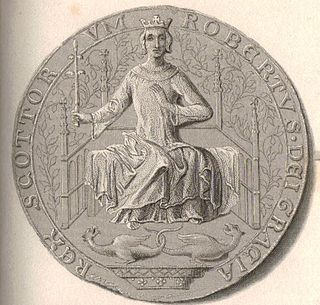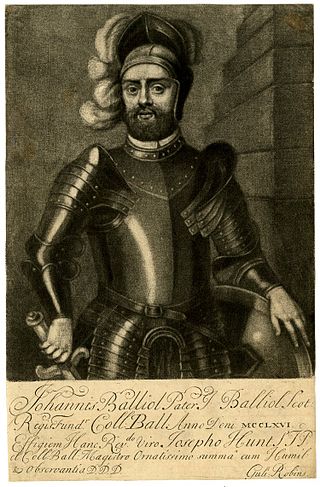
The monarchy of the United Kingdom, commonly referred to as the British monarchy, is the constitutional form of government by which a hereditary sovereign reigns as the head of state of the United Kingdom, the Crown Dependencies and the British Overseas Territories. The current monarch is King Charles III, who ascended the throne on 8 September 2022, upon the death of his mother, Queen Elizabeth II.

John Balliol or John de Balliol, known derisively as Toom Tabard, was King of Scots from 1292 to 1296. Little is known of his early life. After the death of Margaret, Maid of Norway, Scotland entered an interregnum during which several competitors for the Crown of Scotland put forward claims. Balliol was chosen from among them as the new King of Scotland by a group of selected noblemen headed by King Edward I of England.

Robert II was King of Scots from 1371 to his death in 1390. The son of Walter Stewart, 6th High Steward of Scotland, and Marjorie, daughter of King Robert the Bruce, he was the first monarch of the House of Stewart. Upon the death of his uncle David II, Robert succeeded to the throne.

John de Balliol was an English nobleman, belonging to the House of Balliol. Balliol College, in Oxford, is named after him.

The House of Plantagenet was a royal house which originated in Anjou. The name Plantagenet is used by modern historians to identify four distinct royal houses: the Angevins, who were also Counts of Anjou; the main line of the Plantagenets following the loss of Anjou; and the houses of Lancaster and York, the Plantagenets' two cadet branches. The family held the English throne from 1154, with the accession of Henry II, until 1485, when Richard III died.
Robert de Brus, 6th Lord of Annandale, jure uxoris Earl of Carrick (1252–1292), Lord of Hartness, Writtle and Hatfield Broad Oak, was a cross-border lord, and participant of the Second Barons' War, Ninth Crusade, Welsh Wars, and First War of Scottish Independence, as well as father to the future king of Scotland Robert the Bruce.

Robert V de Brus, 5th Lord of Annandale, was a feudal lord, justice and constable of Scotland and England, a regent of Scotland, and a competitor for the Scottish throne in 1290/92 in the Great Cause. He is commonly known as "Robert the Competitor". His grandson Robert the Bruce eventually became King of Scots.
Marie de Coucy was Queen of Scotland by marriage to King Alexander II. She was a member of the royal council during the two last years of the minority of her son, King Alexander III, in 1260–1262.
Guy I de Balliol was a Picard baron who was granted land in northern England in the late eleventh century. In the 1090s, he was established in the north of England by King William Rufus, as part of King William's carve-up of the forfeited earldom of Northumberland.
Bernard I de Balliol, the second-known-ruling Balliol of his line, was a twelfth-century Anglo-Picard baron based for much of his time in the north of England, as well as at Bailleul-en-Vimeu close to Abbeville in northern France. He was the nephew and next known successor of Guy I de Balliol, the first Balliol in England.
Guy II de Balliol was probably the second-eldest son of Bernard I de Balliol, Lord of Balliol and Barnard Castle. As his older brother Enguerrand predeceased their father, Guy succeeded when his father died sometime between 1154 and 1162. He died sometime on or before 1167, and was succeeded by his youngest brother Bernard II de Balliol.
Bernard II de Balliol was the fourth and youngest son of Bernard I de Balliol, lord of Balliol and Barnard Castle. Bernard appears to have succeeded his older brother Guy II de Balliol to the Balliol estates sometime between the early 1160s and 1167.
Eustace de Balliol was the cousin and successor of Bernard II de Balliol, lord of Balliol and Barnard Castle. He was the lord of Hélicourt in Picardy, an estate near the chief seat of the main Balliol line at Bailleul-en-Vimeu; after his cousin died childless, in 1190 Eustace de Helicourt took over those estates and remarried.

Hugh de Balliol, Lord of Bywell, Barnard Castle and Gainford, was an English nobleman. He was the son of Eustace de Balliol and Petronilla FitzPiers. Balliol was a supporter of King John of England during the Barons Wars of 1215–17.

Queen mother is defined as "a queen dowager who is the mother of the reigning sovereign". The term has been used in English since at least 1560.

Edward Balliol or Edward de Balliol was a claimant to the Scottish throne during the Second War of Scottish Independence. With English help, he ruled parts of the kingdom from 1332 to 1356.
The Battle of Kinghorn was fought on 6 August 1332 at Wester Kinghorn, Fife, Scotland. An invading seaborne force of 1,500 men was commanded by Edward Balliol and Henry Beaumont, Earl of Buchan. A Scottish army, possibly 4,000 strong, commanded by Duncan, Earl of Fife, and Robert Bruce, Lord of Liddesdale was defeated with heavy loss. Balliol was the son of King John Balliol and was attempting to make good his claim to be the rightful king of Scotland. He hoped that many of the Scots would desert to him.
Château de Bailleul was a castle in Bailleul, Picardy, France. It was the ancestral home of the English and Scottish Balliol family. The castle once owned by Enguerrand de Bailleul, Admiral of France, was destroyed by the Duke of Burgundy.









